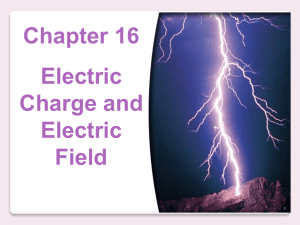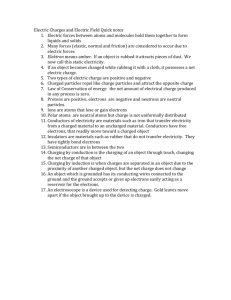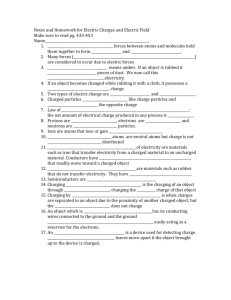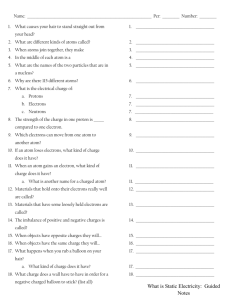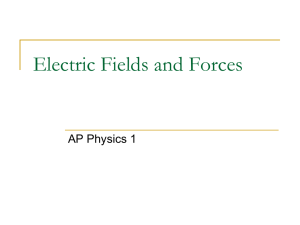Ch 16: Electric Charge and Electric Field
advertisement
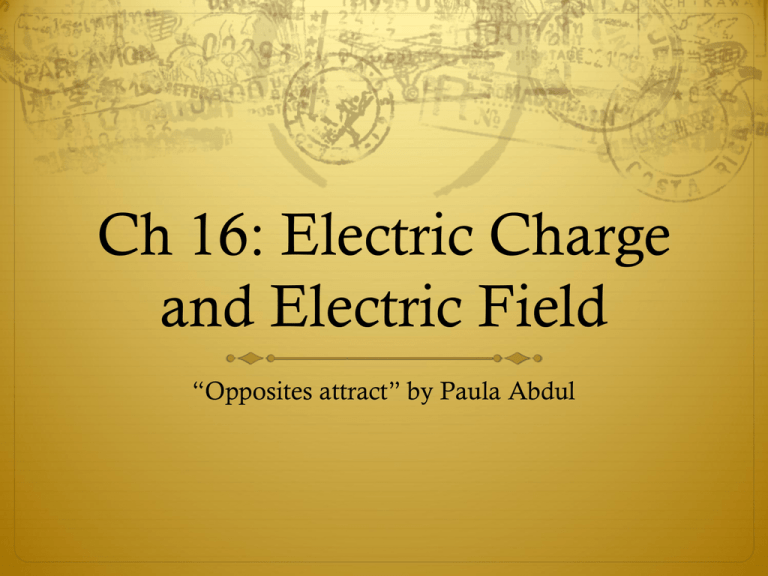
Ch 16: Electric Charge and Electric Field “Opposites attract” by Paula Abdul Static Electricity A neutral object rubbed with another object can acquire a “charge” due to friction. It is said to posses a net electric charge. There are two types of electric charge. Each type tends to repel the same type, but attract the opposite type. These are referred to as positive and negative by Benjamin Franklin (1706-1790). Charge Conservation Franklin argued that whenever a certain amount of charge is acquired by a body in a process, and equal amount of charge is given up by the other body. The net change produced is algebraically the sum of the positive and negatives and equals zero. This is the Law of Conservation of Charge. No violations of this law have ever been found. It all starts with the atom Today’s view of the atom shows it with a heavy positively charged nucleus surrounded by one or more negatively charged electrons. The nucleus contains positive protons and neutral neutrons. This accounts for over 99% of the atom’s mass. The negatively charged electrons around the outside of the nucleus have the same magnitude of charge as the protons. 1+ = 1- Electric Charge in the Atom Neutral atoms contain = numbers of protons and electrons. An ion is an atom that has gained or lost 1 or more electrons and has a net positive or negative charge. A polar object is one that is neutral, but the charge is not distributed uniformly. Water is a “polar” molecule (neutral, but acts as if it is charged). Can you fix the leak? Charged objects caused by friction normally hold their charge for a short period of time and return to their normal state. Charged objects can be neutralized by ions in the air upon collisions with cosmic rays reaching Earth from space. More often, charge can “leak off ” onto water molecules in the air due to the polarity of water. On dry days, static electricity is more noticeable, but on humid days it is difficult to maintain a charge for long. Insulators and Conductors Conductors are materials that carry electric charge easily. Many times these are metals. Insulators are materials that do NOT carry electric charge easily. Wood, rubber, glass, air, plastic, and non metals are insulators. Why? It is believed that good conductors have a large source of loosely bound electrons around the nuclei (such as metals) and insulators have tightly bound electrons. Semiconductors have very few free electrons. Induced charge Another way to acquire a charge on an object is to bring a charged object “near” another object. The presence of the charge causes electrons in the second object to “rearrange” themselves leaving one end more positive or negative than the other. The induced object is still neutral, but ACTS as if it is charged (like polar molecules). Natural Phenomena Lightning is a natural display of static electricity. The clouds acquire charge by winds causing friction and charge there induces an opposite charge in the ground. When the difference is great enough… KABOOM! DISCHARGE! The electroscope How can you tell if an object has a charge? A tool called the Electroscope is used to detect charge. It is not possible to determine the charge (positive or negative) of the leaves without knowing the charge of the object. The leaves will behave the same whether touched by a positive or a negative rod. Methods of Charge transfer Charging by Induction- bring a charge object “near”. Charging by Conduction- touch a charged object to another object. What charge is acquired in each case? How long does it last? Force of charge French physicist Charles Coulomb (1736-1806) investigated electric forces in the 1780s using a torsion balance. This tool helped him come to the conclusion that charges exerted forces on each other directly proportional to the charges of each object and inversely proportional to the square of the distance between their centers. Coulomb’s Law The relationship between charge quantity, Q, and distance, r, is summed up in Coulomb’s Law: Q1Q2 F k 2 r F is the force between the charged objects, which can be attractive or repulsive. Q is the quantity of charge in Coulombs, r is distance between charged bodies (center), and k is a proportionality constant = 9.0 x 109 N-m2 /C2 Units of Charge Charge is measured in units of Coulombs, C, after the inventor of Coulomb’s Law. 1C is the amount of charge which, if placed on each of 2 point objects 1 m apart, will result in each object exerting a force of 9.0 x 109 N on the other. This would be enormous force (almost 1 trillion tons) so we don’t deal with charges this large ordinarily. We deal with charges along the microcoulomb level or smaller. 1 electron has a charge of 1.602 x 10-19 C and its sign is negative. This is the smallest charge known. (elementary charge) so charge on electron is –e and on proton is +e. Quantized charge Electric charge must be quantized or exist in integral multiples of a single charge. (1e, 2e, 3e,…) Since force is a vector, the magnitude between 2 charged objects is given by the formula. The direction of the force is always in a line between the 2 objects. If both objects have negative charge, the force is repulsive. If one object is positive and the other negative, the force is attractive. Remember forces follow Newton’s 3rd law even when dealing with charged objects. Point charges Coulomb’s Law equation applies as long as the “object” is much smaller than the distance between them. For this we treat objects as “point charges” where spatial size is negligible. For finite sized objects it is challenging to determine the exact distance between them since sometimes charge might not be distributed uniformly. The constant k is often written in terms of another constant, 1 0 8.85 x10 12 C 2 / N * m 2 4k Called the permittivity of free space. Coulomb’s law also applies to charges “at rest” as studied in electrostatics. Example 16-1 Determine the magnitude of the electric force on the electron of a hydrogen atom exerted by the single proton (Q2 =+e) that is its nucleus. Assume the electron “orbits” the proton at its average distance of r = 0.53x10-10 m. + Q2 r Q1 16-1 Solution Q1Q2 F k 2 r 9 2 2 19 19 (9.0 x10 N * m / C )(1.6 x10 C )(1.6 x10 C ) 10 2 (0.53x10 m) 8 8.2 x10 N The direction of the force on the electron is toward the proton, since the charges have opposite signs and the force is attractive. Coulomb’s Law & Vectors When several forces act on an object, the net force is the vector sum of the forces. Electrostatic forces are governed by the same laws. Given 2 forces acting on a body, we can use tail-to-tip or parallelogram method to find the resultant. Calculating the magnitude and direction of the resultant sum is better accomplished using vector components. Recall F1x = F1 cos θ1 and F1y = F1 sinθ1 and we use tan-1 to find the angle once we have resultant components. See chs 3 & 4 for more detail. Electric field Unlike contact forces, electric and gravitational forces act at a distance. An electric field extends outward into space around every charge. Lines drawn around a charge indicate the strength of the electric field and the direction a “positive test charge” would go if placed within that field. The electric field, E, at a given point in space will apply a force on a charge, q, such that F=qE. If q is +, then F and E will point in the same direction. If q is -, then F and E will point in opposite directions. Electric Field lines Lines near the charge, where the force is the greatest, are closer together. The closer the lines are, the stronger the field is in that region. Look at figure 16-29 on pg 491. The number of lines drawn is proportional to the magnitude of charge, Q. Between parallel plates oppositely charged, the strength of the electric field has the same magnitude at all points so E=constant. Lines start on positive and end on negative charges. Your turn to Practice Please do Ch 16 Review pg 497 #s 1-9 Please do Ch 16 Rev p 498 #s 12, 22, 24, and 27.

